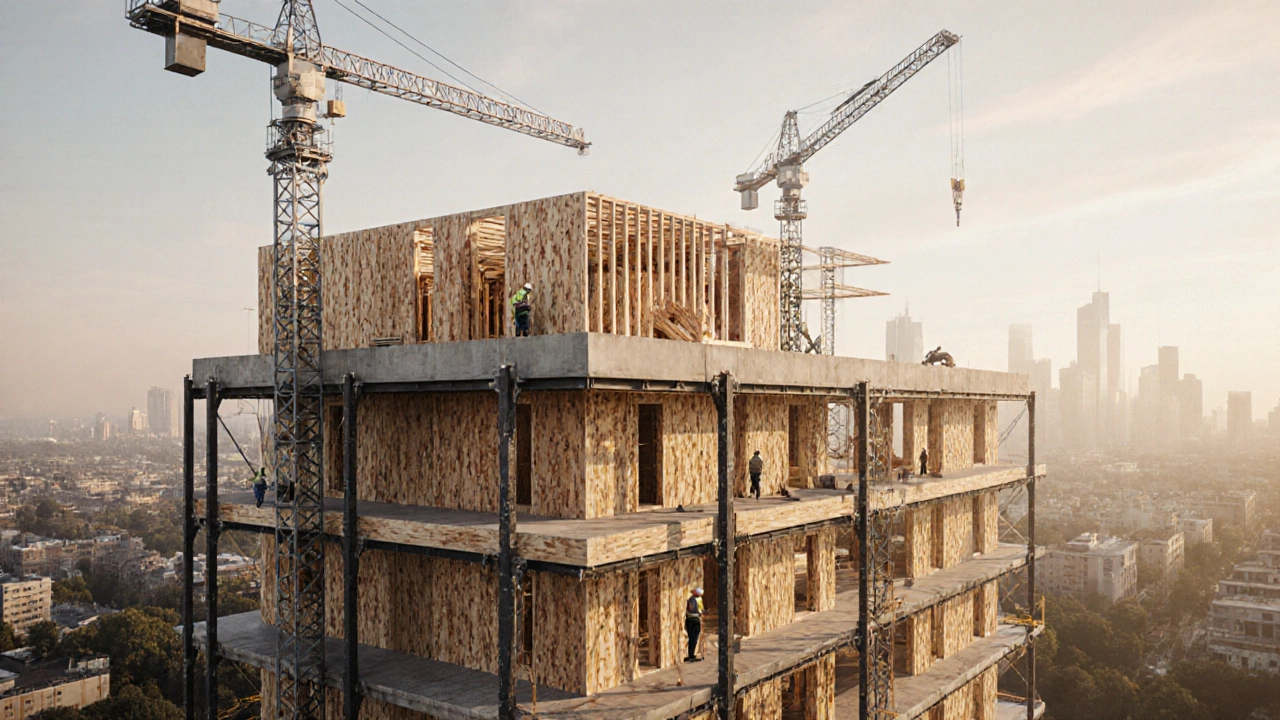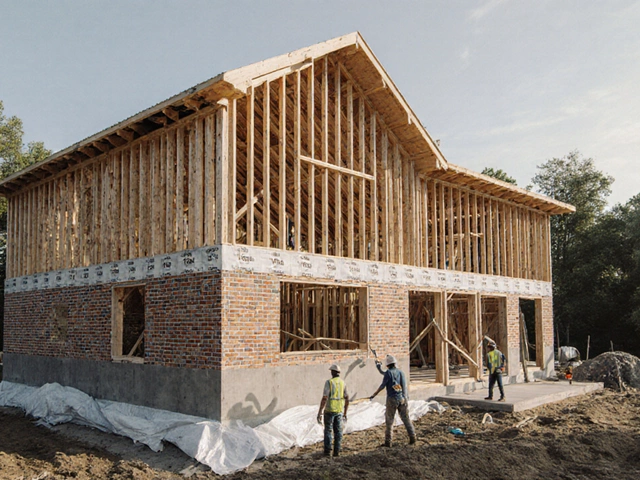Construction Material Selection Tool
Choose Your Project Details
Recommended Materials
Primary Materials
Key Considerations
When you walk past a new house under construction or see a bridge going up, have you ever stopped to wonder what it’s actually made of? It’s not just ‘stuff’-every building starts with a careful choice of construction material. The wrong choice can lead to cracks, mold, or even collapse. The right one lasts decades, saves money, and keeps people safe. So what exactly counts as a construction material, and why does it matter so much?
What Counts as a Construction Material?
A construction material is anything used to build or repair structures. It’s not just the big stuff like bricks or beams-it includes insulation, sealants, fasteners, and even the adhesive used to stick tiles down. These materials are chosen based on strength, cost, availability, weather resistance, and how they interact with other parts of the building.
Think of it like cooking. You wouldn’t use butter to make a cake if the recipe calls for oil. Same here. You can’t just pick wood for a foundation in a flood zone. The material has to match the job.
Concrete: The Backbone of Modern Building
Concrete is the most used construction material on the planet. It’s made from cement, water, sand, and crushed stone. Mix them right, pour it into forms, and let it cure, and you’ve got something that can hold up a 50-story building or a highway overpass.
Why is it everywhere? It’s cheap, fireproof, and handles compression really well. That means it’s great for walls, floors, and foundations. But it’s weak in tension-that’s why steel rebar is embedded inside. This combo, called reinforced concrete, is what makes modern skyscrapers possible.
In Auckland, where earthquakes are a real concern, engineers use special high-strength concrete mixes with fibers added to reduce cracking. It’s not just concrete-it’s engineered concrete.
Timber: The Natural Choice
Timb er-especially treated pine and engineered wood like LVL (laminated veneer lumber)-is the go-to for houses in New Zealand. It’s easy to cut, light to carry, and renewable. Most homes here are timber-framed because it’s fast, affordable, and works well in our damp climate when treated properly.
But timber isn’t just for framing. Cross-laminated timber (CLT) is now used for entire apartment buildings in Europe and Australia. It’s strong enough to replace steel and concrete in mid-rise structures. It also stores carbon-each cubic meter of CLT locks away about one ton of CO₂.
The catch? Moisture. If timber gets wet and stays wet, it rots. That’s why we use treated timber, proper ventilation, and raised foundations in New Zealand homes. You can’t ignore the weather.
Steel: Strength Without the Bulk
Steel is the muscle behind bridges, factories, and high-rises. It’s made from iron and carbon, then shaped into beams, columns, and sheets. Unlike concrete, it handles tension and compression equally well. That’s why it’s the top pick for long spans and tall buildings.
In commercial construction, steel frames let you build wider open spaces without needing thick load-bearing walls. That’s why warehouses and shopping malls use it. It’s also faster to assemble-steel beams are pre-cut and bolted on site, cutting weeks off construction time.
But steel rusts. In coastal areas like Auckland, it needs protective coatings or galvanization. And it’s expensive. That’s why you don’t see it in every backyard shed.

Brick and Stone: Built to Last
Brick is one of the oldest construction materials still in use today. Made from clay baked in kilns, it’s durable, low-maintenance, and gives a classic look. In New Zealand, brick is common on exteriors, especially for homes built in the 1970s-90s.
It’s not structural on its own in most modern builds. Instead, it’s a veneer over a timber or steel frame. That saves weight and cost. But it still adds thermal mass-meaning it absorbs heat during the day and releases it slowly at night. That helps keep homes warmer in winter and cooler in summer.
Stone is rarer now because it’s heavy and expensive to transport. But you’ll still see it in heritage buildings or as decorative accents. Natural stone like basalt or limestone doesn’t rot, burn, or rust. It just sits there-quietly lasting for centuries.
Insulation and Air Barriers: The Invisible Heroes
Most people think of walls and roofs when they think of construction materials. But the real game-changers are the invisible ones: insulation and air barriers.
Mineral wool, polystyrene foam, and cellulose insulation keep heat in during winter and out during summer. In New Zealand’s changing climate, building codes now require higher insulation levels than ever before. A house built in 2025 needs at least R-3.3 in walls and R-4.0 in ceilings-up from R-2.0 just ten years ago.
Air barriers-like house wraps or spray foam-are just as important. They stop drafts and moisture from sneaking into walls. Without them, even the best insulation won’t work. Condensation inside walls leads to mold, which leads to health problems and expensive repairs.
Composite and Emerging Materials
The future of construction isn’t just about old favorites. New materials are popping up all the time.
Engineered bamboo is now used in flooring and wall panels. It’s stronger than many hardwoods and grows in just 5 years. Recycled plastic lumber is replacing wood in decks and boardwalks-it doesn’t rot, and it’s made from milk jugs and detergent bottles.
Then there’s self-healing concrete. It contains bacteria that activate when water enters cracks, producing limestone to seal them. It’s still expensive, but pilot projects in the Netherlands and Japan show it could cut maintenance costs by half over 50 years.
3D-printed concrete homes are being built in Europe and Australia. In 2024, a home in Christchurch was printed in under 48 hours using a robotic arm. It used 60% less material than traditional builds.

How to Choose the Right Material
There’s no single ‘best’ construction material. The right choice depends on:
- Location: Coastal? Use corrosion-resistant steel or treated timber. Earthquake zone? Reinforced concrete or flexible steel frames.
- Climate: Cold and wet? Prioritize insulation and moisture control. Hot and dry? Think thermal mass like brick or stone.
- Budget: Timber is cheaper upfront. Steel costs more but lasts longer. Concrete is mid-range but needs skilled labor.
- Design goals: Want an open-plan space? Steel or glulam beams let you remove walls. Want a rustic look? Brick and timber work best.
- Sustainability: If you care about carbon, choose timber, recycled steel, or low-carbon concrete mixes.
There’s no shortcut. You have to match the material to the problem. A $50,000 steel frame won’t help if your foundation is sinking because you used untreated timber in damp soil.
Common Mistakes to Avoid
- Using untreated timber in bathrooms or near the ground. It will rot in 3-5 years.
- Skipping vapor barriers under slabs. Moisture rises, then condenses inside walls.
- Choosing cheap insulation that compresses over time. It loses half its R-value within 10 years.
- Using standard concrete in freeze-thaw zones without air-entrainment. It cracks like glass.
- Assuming ‘green’ materials are always better. Bamboo is great-but if it’s shipped from Asia, the carbon cost might cancel out the benefit.
These aren’t theoretical risks. I’ve seen homes in Tauranga with timber frames that collapsed because the bottom plate was buried in soil. No one checked the building code. It was fixable-but it cost $80,000.
What’s Next for Construction Materials?
By 2030, most new homes in New Zealand will use low-carbon concrete, recycled steel, and cross-laminated timber. Building codes are tightening, and material suppliers are responding.
Some companies are even making bricks from recycled glass or mine tailings. Others are developing timber that’s fire-resistant without chemicals. The goal isn’t just to build faster-it’s to build smarter, cleaner, and longer-lasting.
The material you choose today isn’t just about today’s cost. It’s about what your house will look like in 20, 40, or 60 years.
What is the most common construction material used in homes?
In New Zealand and many other countries, timber is the most common material for home framing. It’s affordable, easy to work with, and well-suited to local conditions when properly treated. Concrete is used for foundations and slabs, while brick often serves as an exterior cladding. The combination of timber frame, concrete base, and brick or weatherboard cladding is standard for most residential builds.
Is steel better than concrete for building houses?
It depends on the project. Steel is stronger and lighter, making it ideal for large open spaces, multi-story buildings, or areas prone to earthquakes. But for a typical single-family home, timber is cheaper and easier to install. Concrete is better for foundations and floors because it resists moisture and fire. Steel and concrete aren’t rivals-they’re partners. Most homes use both, just in different parts.
Can you use wood in commercial buildings?
Yes, and it’s becoming more common. Engineered wood like cross-laminated timber (CLT) and glue-laminated beams (glulam) are now used in office buildings, schools, and even apartment blocks up to 10 stories tall. These materials are fire-resistant when properly designed, and they store carbon. In 2023, a 12-story timber apartment building opened in Wellington-proof that wood can compete with steel and concrete.
What’s the most durable construction material?
Stone and brick are among the most durable, lasting hundreds of years with little maintenance. Steel and concrete can also last a century or more if protected from corrosion and cracking. But durability isn’t just about the material-it’s about how it’s used. A well-built timber home with proper drainage and ventilation can outlast a poorly built concrete one. Maintenance matters as much as the material itself.
Are there eco-friendly construction materials?
Yes. Timber from sustainably managed forests stores carbon. Recycled steel uses 75% less energy than new steel. Low-carbon concrete mixes replace part of the cement with fly ash or slag. Insulation made from recycled denim or cellulose (ground-up newspaper) avoids petroleum-based foams. Even bricks can now be made from industrial waste. Choosing these materials reduces the environmental footprint of a building.
How do I know if a material is suitable for my climate?
Check your local building code. In New Zealand, the Building Code sets minimum requirements for insulation, moisture control, and structural performance based on climate zones. Coastal areas need corrosion-resistant materials. Wet regions require better drainage and vapor barriers. Cold areas need higher insulation values. Don’t guess-consult a builder or architect familiar with your region’s conditions.

Write a comment